Barn Blog: The Spectrum
(Source: http://www.igglesblog.com)
Name: The Spectrum
Team: Philadelphia Flyers (1967–1996), Philadelphia Phantoms (1996–2009)
Location: Philadelphia, Pennsylvania
Year Built: 1967
Year Demolished: 2011
Capacity: 17,500
In the midst of the NHL expansion, the Spectrum was built to house the Philadelphia Flyers. Ed Snyder remembers “In the mid-’60s we wanted to bring a hockey franchise to Philadelphia and had to build a new building to obtain one. We completed it in 11 months, only 16 months after we had the idea. That’s pretty amazing when you stop and think about it.” The Spectrum was built on the corner of Broad Street and Pattison Avenue, a fact that would later have the Flyers come to be known as “the Broad Street Bullies.” After consecutively losing to St. Louis Blues in the first round of the playoffs, the Flyers decided they wouldn’t let themselves get beat up again. Over the next couple of years the Flyers would accumulate bigger, stronger and tougher players. Soon Ed Snyder found his team all over the papers and intimidating the other teams.
The Spectrum’s story begins when it was built by the architectural firm of Skidmore, Owings and Merrill. Construction was started on June 1st and finished in only 11 months. According to former president of the Spectrum Lou Scheinfeld “’Spectrum’ was selected to evoke the broad range of events to be held there. The ‘SP’ for ‘sports’ and ‘South Philadelphia,’ ‘E’ for ‘entertainment,’ ‘C’ for ‘circuses,’ ‘T’ for ‘theatricals,’ ‘R’ for ‘recreation,’ and ‘UM’ as ‘um, what a nice building!” The new building opened on September 30, 1967 with the Quaker city Jazz festival. The first Flyers home game would not be played until October 19, 1967. In front of 7,812 fans the Flyers shutout the Pittsburgh Penguins 1-0 with Bill Sutherland scoring the arena’s very first goal.
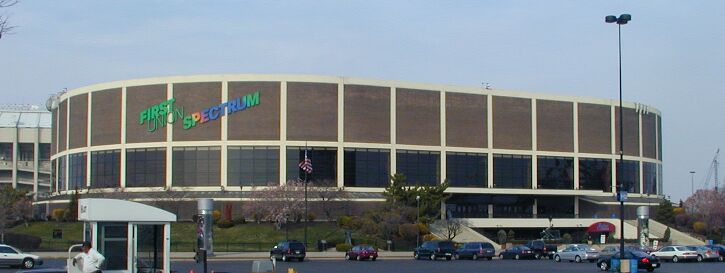
(Source: http://www.thesportsroadtrip.com)
Over the next few years, the Spectrum would see many memorable moments and events that would come to live forever in the hearts of the fans. Within its first season, the Spectrum was already beginning to see drama. On March 1, 1968 as the Ice Capades were being held in the building, strong winds actually ended up blowing part of the roof off. This presented a problem for the Flyers as their season was still in session. They ended up having to move their games into other various venues including: one game at Madison Square Garden and one at Maple Leaf Gardens before settling in at Le Colisee in Quebec City. Luckily they would end up winning the division and were able to return to the Spectrum on April 4, 1968 for the first round of playoffs against St. Louis Blues. Unfortunately they lost both that season and the next, but through these events, the “Broad Street Bullies” were born.
After losing to St. Louis Blues two playoff seasons in a row, Ed Snyder, not wanting his team to be physically outmatched again, instructed his GM Bud Poile and coach Keith Allen to acquire bigger, tougher players. This would lead to one of the most feared teams ever to take the ice in the NHL. The Broad Street Bullies were both heroes who unified their city and enemies who were seen as just a bunch of goons who some believe disgraced the face of hockey. The first man drafted to turn the Flyers’ game around was Dave “The Hammer” Schultz. Before coming to the Flyers he had never fought before, but once he got to Philly, he sparked the whole team into becoming some of the most feared fighters in the NHL. Pretty soon, the team started winning and became the first team to use fighting and intimidation as a tactic to win. By 1974, they would claim their first Stanley Cup.
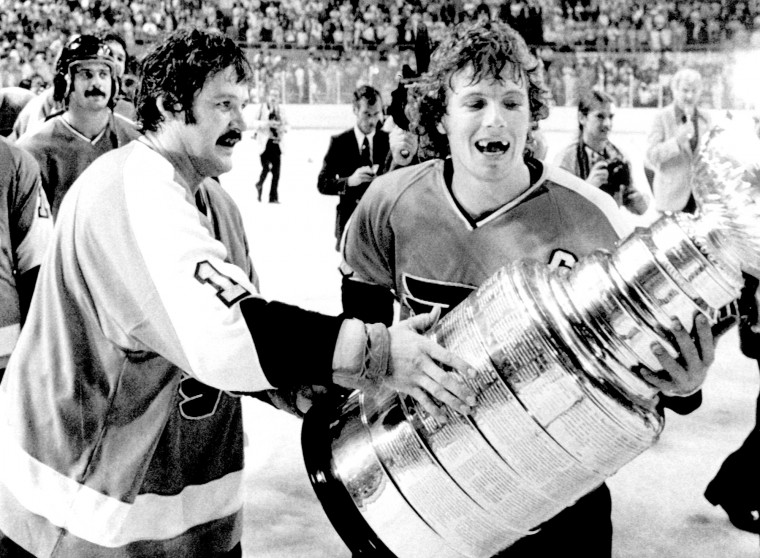
(Source: http://bloximages.newyork1.vip.townnews.com/phillyburbs.com)
After seven years of trying, the Flyers finally came out on top as the Spectrum saw its first Stanley cup. With a mix of their fighting tactics and with their good luck charm Kate Smith singing “God Bless America” the Flyers made history by being the first expansion team to win the Stanley Cup. In an exciting game, the Flyers beat Boston 1-0 as fans waiting outside the stadium swarmed the ice to celebrate along with the team. Not only that, but they would go on to win the cup in the following season on the road as well. Still they would return to the Spectrum to celebrate with their fans.
The drama would continue throughout the years. On January 11, 1976 the Flyers took on and angered the Soviet Red Army thought to be the best team in the world. By using their regular rough and tough playing style, the Flyers infuriated the Red Army coach Konstantin Loktev. “We have never played [against] such animal hockey.” Tension started early in the first period as the Red Army was already making complaints about the Flyers. In the first period the Flyers’ defenseman Ed Van Impe hit the Red Army’s top player Valeri Kharlamov. This caused the Russian coach to pull his team off the ice. Ed Snyder got into a shouting match with the President of the Soviet Hockey federation. Eventually Snyder threatened that if they didn’t finish the game, they wouldn’t get paid. The Red Army would begrudgingly go back out on the ice and finish the game. They would later lose the game to the Flyers 4-1. According to Flyershistory.com, Flyers Coach Fred Shero considered it the most important game he ever coached, “Yes we are world champions. If they had won, they would have been world champions. We beat the hell out of a machine.”
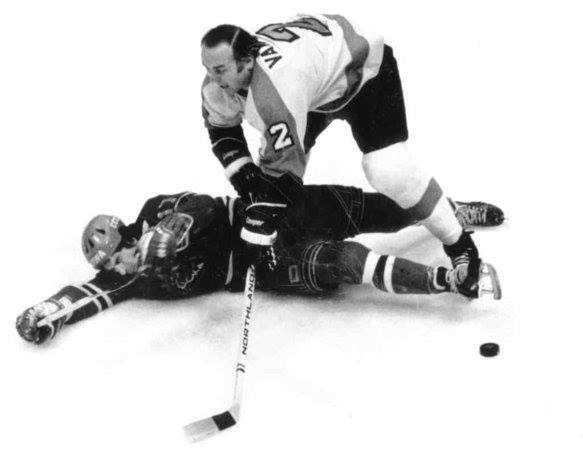
(Source: http://media-cache-ak0.pinimg.com)
The Spectrum saw many other firsts during its years as well. On December 8, 1987 Flyers’ goalie Ron Hextall became the first goalie in NHL history to score a goal. As the Flyers took on the Boston Bruins and were leading 4-2, the Bruins pulled their goalie to leave a wide open net. With little time left, Hextall claimed possession of the puck and shot the puck through all the players, across the full length of the ice and into the net for a history-making goal. According to USA Today, 27 years later Hextall commented, “I never at one point in my career thought, ‘I’ve got to score a goal.’ It wasn’t a goal of mine or anything like that,” Hextall said. “When it happened, the way my teammates reacted to it made it pretty special for me.”
The Spectrum saw many great players throughout the years as well. By the time the Phantoms moved in, the Spectrum already had four retired number banners hanging from the rafters. This included, Barry Ashbee (#4), Bill Barber (#7), Bobby Clarke (#16), and Bernie Parent (#1). For a short period, the Spectrum housed both the Flyers and the Phantoms along with other sports teams including: The Philadelphia 76ers (Basketball), The Philadelphia Wings (Lacrosse), Philadelphia KiXX (Soccer), Philadelphia Soul (Football), Philadelphia Freedoms (Tennis), Philadelphia Bulldogs (Roller Hockey) and Philadelphia Fever (Soccer). Along with these the Spectrum saw many other entertaining events, electrifying concerts and thrilling spectacles.
As the years turned to 2009, the Spectrum’s story was beginning to end. On April 10, 2009 the Phantoms played the last ever hockey game at the Spectrum. They took on their local rivals the Hershey Bears and beat them 5-2 in front of 17,380 fans, some in standing-room-only sections. The stadium workers made sure to commemorate all of the hockey history of the Spectrum by raising a banner with “The Final Home Game” written on the top and the radio announcer Gene Hart’s popular sign-off phrase “Good night and good hockey” written across the bottom. The Spectrum officially closed on October 31, 2009, however its demolition did not begin until later. On November 8, 2010, internal work commenced as memorabilia such as seats, bricks and other pieces of the building were taken out and sold or auctioned. Then on November 23, 2010, the final “wrecking ball ceremony” was held with many of the athletes and entertainers who made the building famous. By May 2011, the demolition of the Spectrum was finally completed without the use of explosives. The Spectrum’s 44 years of memory making were finally put to an end, but its stories continue to be shared today, by those who were there.

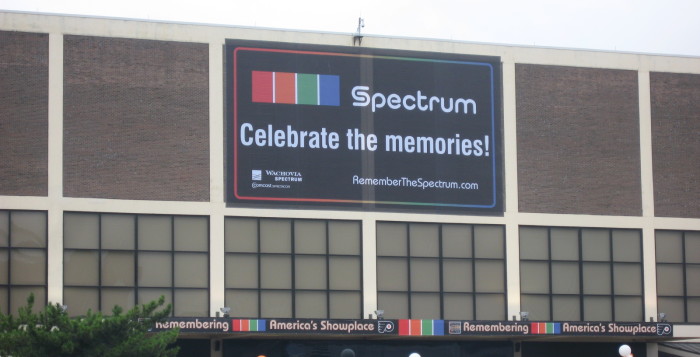
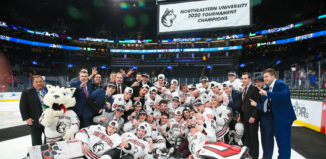
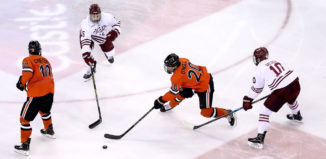











[…] https://thepinkpuck.com/2014/12/24/barn-blog-the-spectrum/ […]